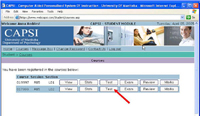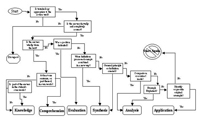|
PAPERS
Teaching
Large Classes in a Virtual Environment While Still
Actively Engaging Students in the Learning Process
Joseph
J. Pear
University
of Manitoba
Abstract
An online, automated
method that approximates private tutors through the use of
peer reviewers enables large classes to be taught in a virtual
environment while still actively engaging students in the
learning process. The method is highly flexible and easy to
implement for practically any course.
Introduction
In the ideal educational
system, each student would have a private tutor who initiates
student inquiry, probes the student’s knowledge, provides
constructive feedback, and thus actively engages the student
in the learning process. Clearly, except for the very rich,
this type of academic education has never been practical.
In 1968, however, the psychologist Fred S. Keller described
a close approximation to having private tutors for students
in a large class. In this method, which is called personalized
system of instruction (PSI), students proceed through course
material at their own pace by writing unit assignments on
study questions or problems designed to initiate student inquiry
(Keller, 1968). Other students, who generally are in a more
advanced course, act as reviewers or tutors by evaluating
and giving feedback on the unit assignments. PSI is a mastery
system since students demonstrate mastery on a given unit
before they can proceed to the next unit.
Automating
PSI
By automating repetitive
tasks, computer technology increases the efficiency of PSI.
In addition, with computer technology, obtaining reviewers
from a more advanced course is unnecessary because each student's
current level of mastery is available instantaneously to the
computer. An added benefit of computer technology is that
students do not all have to be at one specific location at
one specific time – they can do their assignments and
their peer reviewing in a virtual environment.
A method called computer-aided
personalized system of instruction (CAPSI) used at the University
of Manitoba incorporates the above ideas to actively engage
students in the learning process in a virtual environment
(Pear & Crone-Todd, 1999; Pear & Novack, 1996). To
ensure high-quality student involvement, CAPSI has built-in
quality control procedures. The program requires that a student’s
unit assignment be evaluated by the instructor or teaching
assistant or by two more advanced peer reviewers. If two peer
reviewers evaluate it, the program will not record a pass
unless both independently agree that the student has demonstrated
mastery. In addition, all assignments are automatically recorded
for the instructor to sample and evaluate. There is also a
built-in appeal process for arguing the validity of a given
answer or solution.
Applicability
of the Program
The program is applicable
to any course topic and any set of questions or problems.
The instructor selects the study material and inputs questions
or problems and certain parameters; e.g., number of units
in the course, the course credit for each unit assignment,
the course credit for peer reviewing, and whether there are
to be examinations or projects in the course and their respective
course credits. The program then automates all the administrative
functions of the course.
Thus, the study material
and the questions, exercises, and problems form the core of
the system. The type of learning that students can acquire
from the course depends on this core. For this reason CAPSI
is designed for constructed or composed solutions or answers
rather than option-based (e.g., true-false, multiple choice)
responses. In addition, procedures for initiating higher-order
thinking have been integrated into the system to help ensure
that students actively engage the course material to the fullest
extent (Crone-Todd, 2001; Crone-Todd, Pear & Read, 1999;
Pear, Crone-Todd, Wirth & Simister, in press).
References
Crone-Todd, D. E.
(2001). Increasing the levels at which undergraduate students
answer questions in computer-aided personalized system of
instruction courses. PhD thesis submitted to the University
of Manitoba.
Crone-Todd, D. E.,
Pear, J. J., & Read, C. N. (2000). Operational definitions
of higher-order thinking objectives at the post-secondary
level. Academic Exchange Quarterly, 4, 99-106.
Keller, F. S. (1968).
"Good-bye Teacher...". Journal of Applied Behaviour Analysis,
5, 79-89.
Pear, J. J., &
Crone-Todd, D. E. (1999). Personalized system of instruction
is cyberspace. Journal of Applied Behavior Analysis,
32, 205-209.
Pear, J. J., Crone-Todd,
D. E., Wirth, K., & Simister, H. (in press). Assessment
of thinking level in students' answers. Academic Exchange
Quarterly.
Pear, J. J., &
Novak, M. (1996). Computer-aided personalized system of
instruction: A program evaluation. Teaching of Psychology,
23, 119-123.

|




